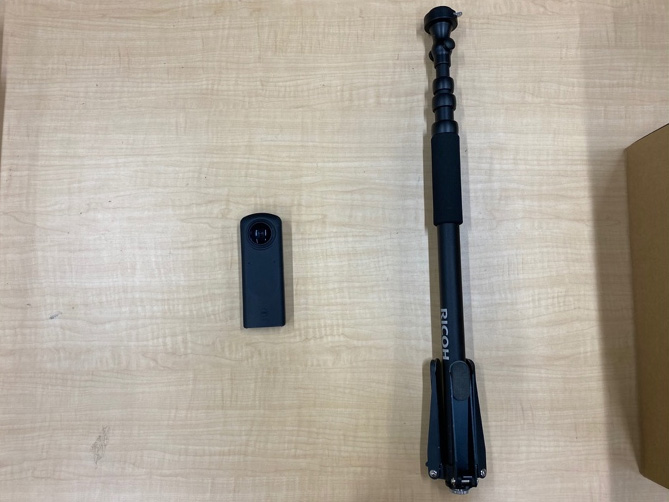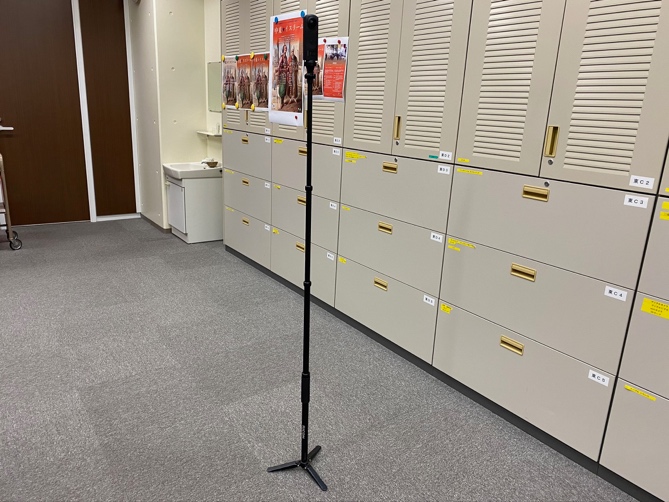Photography Approach and Issues
*Locale-specific details are current as of March 2020.
Photography Approach
The 360-degree spherical panoramic photos of the Qalawun complex were shot with a Ricoh Theta series Z1 omnidirectional camera, a consumer camera released in February 2019. We were experimenting to determine what quality of photos could reasonably be expected when using this device without particular expertise. The Ricoh Theta Z1 camera is a consumer-targeted omnidirectional camera with a still image resolution of 6720 x 3360 pixels, and capable of shooting 4K video. (For more about its specifications, please refer to the Ricoh website.) The camera is mounted on a special tripod when shooting, and can be remote-controlled via a wireless connection to a handheld smartphone. The photographer hides someplace out of the camera’s view and triggers the shutter remotely. You can also change the exposure mode and other camera settings wirelessly via smartphone.


The Ricoh Theta Z1 camera used for the 360-degree spherical photography.
(Courtesy: Field Science Center [FSC], Research Institute for Languages and Cultures of Asia and Africa,
Tokyo University of Foreign Studies)
(August 2019)
On August 30th and 31st 2019, we conducted test shoots with an omnidirectional camera and a single-lens camera inside the Qalawun complex and near the entrance in order to plan out which shooting positions would be required for the photographs used to create the virtual panoramic tour.
The subsequent on-site shoots went according to the planned schedule. The photography team consisted of project members Naoko Fukami, Manabu Kameya, Takenori Yoshimura, Ryosuke Kubo, Mohamed Soliman, and collaborator Masae Mabuchi from the JSPS Cairo Research Liaison Center. We brought along two omnidirectional cameras (owned by the TUFS-ILCAA Field Science Center) and a total of three personally-owned single-lens cameras. In Egypt, shooting at such sites with a large-format camera requires special permission from the relevant governmental agencies, which is said to take some time. Because the omnidirectional cameras we were using were about the same size as a smartphone or small digital camera [48 mm wide x 132.5 mm tall x 24~29.7 mm deep], we didn’t need special permission. To bring these and our tripod in, we only had to purchase a camera-user ticket and a tripod-user ticket, in addition to the admission fee, at the facility entrance.
Our knowledgeable local coordinator Mohamed Soliman led the shooting on-site. Still, we did not have complete freedom. We encountered some restrictions. As explained above, shooting with a large-format camera requires special permission. For new omnidirectional cameras, however, the rules are unclear, leaving permission to the discretion of the facility management (that is, to an inspector from the Ministry of Antiquities). To avoid unnecessary trouble, we worked swiftly. This made careful settings, photo checking, and retakes impractical. Nevertheless, free and liberal use of our single-lens cameras captured images of areas where the omnidirectional camera image quality fell short.
Most of the panoramic images you see in the VR tour, except some of the hospital, were taken at this time. As you can see, the image quality varies significantly depending on the conditions at the shooting location. Glare caused by sunlight is a particular problem. In the harsh August sunlight, steps to avoid glare are crucial when shooting outdoors, or even indoors. This problem can be somewhat remedied with adjustments to camera settings, but is difficult to solve completely.
In light of these issues, the second shoot (the panoramic images of the hospital section) was carried out in winter, in February 2020. The participants at the second shoot were team leader Wakako Kumakura and local coordinators Masae Mabuchi and Ehab El-Khatib (of the Egyptian Antiquities Ministry). The main sections photographed at this time were the courtyard enclosed by the hospital’s iwan and the interior of the iwan. El-Khatib acted as our on-site negotiator, which enabled us to once again bring in our omnidirectional cameras without special permission. Still, for the reasons explained above, El-Khatib was uneasy about shooting for very long. So again, we had to work swiftly.
The images below were taken at this time. With the noise reduction mode enabled, and without much use of the dynamic range compensation, we were able to get fairly consistent image quality with less of the glare that occurred in the August photo shoot. The degree of lens flare in the images was also tolerable. We were unable to avoid the glare when photographing toward the outdoors from inside.
Working this way, our combined summer and winter shoots yielded 53 panoramic images and a plethora of still images. Shooting inside the section that still functions as a hospital requires special permission, so those areas have yet to be photographed. But we do plan to get permission and photograph those areas at some point in the future.
Shooting Issues
These photo shoot experiences revealed certain issues that need to be addressed.
First, the approach to the photography clearly must take Egypt’s harsh sunlight into consideration. It is formidable in summer, and the tiles on the walls and floors of stone buildings act as reflectors, causing additional glare and lens flares. So, when shooting in summer, it is essential to have suitable equipment and use appropriate settings to address this.
Second, our tripod was 150 cm tall, which prevented us from taking detailed pictures of the higher parts of these buildings. Photographing the details of those sections with our current equipment would require a longer tripod, which would likely require a special permit. We’ll need to think about how to approach photographing these higher sections.
Third, the issue of distance between shooting positions. Because these were our initial photo shoots, our priority was showing the whole complex. This limited the shooting positions to only those required. When assembling these photos into the VR tour, we recognized the significant distance from point to point, and the resulting sense of discontinuity. With this in mind, increasing the number of shooting points should enable smoother spatial transitions.
And lastly, these shoots demonstrated that “unwritten rules” among the Qalawun complex’s on-site managers must be taken into account. To that end, a certain amount of advance preparation is required to establish a good relationship with the complex’s on-site managers. Also, the use of remote-controlled equipment seems to have caused some suspicion among the local people whenever the photographer hid behind objects to avoid being seen in the photo. In contrast, when we used a single-lens camera, no matter how long it took, the facility managers had no complaints.
Given the insights above, we believe we can resolve some of these issues by using a single-lens camera. For example, the use of a lens hood should help address the lens flare problem. Also, shooting with a single-lens camera would seemingly be less impeded by “unwritten rules”. In 2023, we plan to start working on an improved quality VR tour with panoramic images from a single-lens camera with a fisheye lens.
English translation: Jeff Gedert